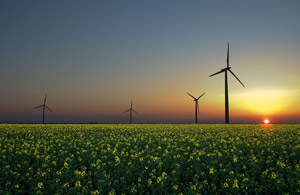While everyone's been fixated on oil, renewable energy has been gathering some serious steam.
Led by solar power, worldwide capital investment in "clean" energy surged by more than 16% last year.
In fact, spending on renewable energy was so strong in 2014, some have begun to label the recent rush into renewables as a "turning point" in the energy balance.
According to a report last week from Bloomberg New Energy Finance (BNEF), the total invested in renewable power jumped to $310 billion, just $17 billion shy of the all-time record in 2011.
But here's the real kicker...
Since renewable energy is now much cheaper to generate, last year's investment brought in almost double the clean electricity capacity versus what was realized only four years earlier.
That's undoubtedly a bullish sign...
A Brewing Solar Power Boom
 Of course, these figures don't tell the whole story about renewables.
Of course, these figures don't tell the whole story about renewables.
For one thing, the global renewable picture is very uneven. While new projects have moved forward in the Middle East and certain parts of Asia, the biggest move has been largely spearheaded by solar power investment in the United States and China.
Meanwhile, had it not been for some large-scale offshore wind farms in Europe, investment there would have been in negative territory. And in Australia, where there had been signs of a major initiative, lack of government support has resulted in an absolute contraction in support for renewables.
But as the British newspaper The Guardian noted on Friday, BNEF Chairman Michael Liebreich said, "The investment bounce back in 2014 exceeded our expectations," adding, "Solar was the biggest single contributor, thanks to the huge improvements in its cost-competitiveness over the last five years."
In all, solar investment rose by 25%, while wind power rose 11% to account for a third of all investment in 2014. Meanwhile, energy efficiency and electric vehicles rose 10%, including the $2.3 billion raised by Tesla Motors Inc. (Nasdaq: TSLA). On the downside, biofuels investments fell 7% and biomass and incinerator projects attracted 10% less financing.
However, one thing is perfectly clear:
China is emerging as a dominant player in renewable energy. For the year, China accounted for $90 billion in renewable spending, a year-on-year increase of 32%. The United States ranked second with $52 billion, up 8%, while Japan totaled $41 billion, an increase of 12%.
Of course, totaling national performances is sometimes misleading when it comes to assessing the genuine impact on developing energy markets.
There is no question, however, that the renewable market in general - and most certainly solar in particular - is gravitating toward Asia.
In addition to leading the table on total investment, China is also the center of next-generation solar technology and is beginning to occupy a similar position in wind power.
Given the dramatic move in energy demand in Asia through 2035, the new balance emerging among different energy sources will be progressively determined by the needs and developments there.
Meanwhile, The Guardian notes that the mega-solar and onshore wind projects financed in 2014 included the $1 billion Setouchi solar project in Japan, the $1 billion Solar One plant in South Africa, and the $860 million Lake Turkana wind project in Kenya.
Additionally, there were also seven mega offshore wind projects, including the $2.6 billion Dudgeon project in U.K. waters and the $3.8 billion Gemini series off the Netherlands, which is the most valuable renewable energy investment ever made excluding hydroelectric. Rooftop solar also had a strong year, jumping 34% to $74 billion.
All of this occurred in the face of falling oil prices, which had little effect on clean energy investments. According to Liebreich, "2014 was too early to see any noticeable effect on investment, and anyway the impact of cheaper crude will be felt much more in road transport than in electricity generation."
Renewable Energy Will Power the Economic Recovery
On the other hand, as I have noted on several occasions, the same thing is not true for the average returns of renewable energy stocks. The collapse in oil has hurt energy sector share prices virtually all across the board.
But as Ed Davey, the U.K.'s energy and climate change secretary, told The Guardian: "Renewables are proving they can be cost competitive, which is why they are playing a key role in powering the economic recovery. We are transforming our electricity market [and] that's why the U.K. is a leading destination for renewables and is number one for offshore wind. Since 2010, renewable electricity generation has almost trebled and renewable electricity investment has more than doubled."
In agreement, Richard Black, director of the Energy and Climate Intelligence Unit, states, "The figures show that renewable energy is increasingly cost-competitive, with solar in particular rapidly approaching parity with fossil-fuel generation. They suggest also that investors are growing weary of increasingly volatile fossil fuel markets," while "some developing countries have increased low-carbon investment hugely - a staggering 88% in the case of Brazil."
The concern going forward will be how the average investor can make money on the confluence of major project investments and the ongoing uneasiness about individual company strengths.
I will be discussing these issues again in the New Year. And as soon as the trends stabilize among the renewable energy providers on my tracking lists, I'll have the foundation of an operational strategy. So stay tuned.
It's shaping up to be a profitable year for this portion of the sector.
Pundits are squawking left and right about the fall in crude oil... They say it's all due to surging global supply led by tight and shale oil production in the United States. But they're missing the one factor that virtually guarantees an increase in oil prices this year...
About the Author
Dr. Kent Moors is an internationally recognized expert in oil and natural gas policy, risk assessment, and emerging market economic development. He serves as an advisor to many U.S. governors and foreign governments. Kent details his latest global travels in his free Oil & Energy Investor e-letter. He makes specific investment recommendations in his newsletter, the Energy Advantage. For more active investors, he issues shorter-term trades in his Energy Inner Circle.



